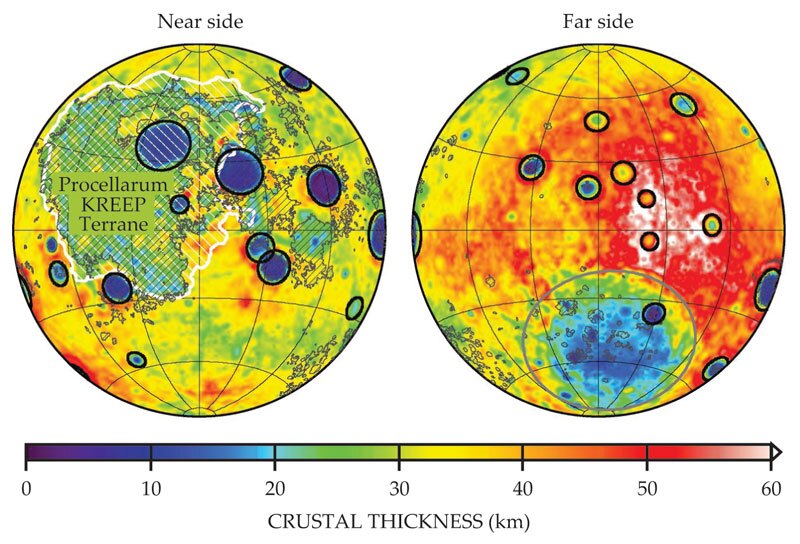Explaining our two-faced Moon
DOI: 10.1063/PT.3.2232
When the far side of the Moon was first photographed by the Soviet probe Luna 3 in 1959, its visage was immediately puzzling: Although heavily cratered, the far side lacked the dark, vast lava flood plains visible on the near side, and its impact basins—craters so huge they develop complex morphologies—appeared smaller and less numerous than those on the near side.
With the absence of weather and plate tectonics, the Moon’s craters preserve a record of the early solar system—in particular a time roughly 4 billion years ago during the so-called late heavy bombardment when the Moon received most of its scars. Since the 1970s scientists have used that record, together with isotopic analyses of Moon rocks, to date the surfaces of other rocky planets.
But understanding how the basins formed and what accounts for their asymmetry on the near and far sides has been hampered by the lack of consensus on the largest basins’ sizes. Most are filled with lava, have ill-shaped rims from the inward collapse of crust, or contain multiple concentric rings—the frozen remnants of the enormous shock wave on impact. Such features frustrate attempts to quantify the width of the original basins.
In 2012 the GRAIL (Gravity Recovery and Interior Laboratory) mission got around those obstacles. For nine months two spacecraft, Ebb and Flow, flew in tandem in a shallow lunar orbit that eventually passed over the entire surface. As the Moon’s gravitational pull on the two spacecraft varied from changes in terrain, so did their rate of separation, measurable to within tens of nanometers per second. The mission allowed the GRAIL team to map the gravity field in fine detail.
Mark Wieczorek (Paris Institute of Earth Physics) and colleagues removed the effects of topography from the data and used the residual field to map the thickness of the crust. 1 The ejection of material from an asteroid impact is so great that it and the subsequent uplifting of the underlying mantle from the release of pressure dramatically thin the crust. So the researchers’ map of thickness variations, shown in the figure, unmasked the hidden craters and unambiguously determined their sizes.

A global map of the Moon’s crustal thickness, derived from the gravity field data measured during NASA’s GRAIL (Gravity Recovery and Interior Laboratory) mission, reveals 12 impact basins (circled in black) with diameters greater than 200 km on each hemisphere. That number excludes the far side’s South Pole–Aitken basin (circled in gray), thought to have formed during a much earlier epoch than the other basins. The near side is dominated by the Procellarum KREEP Terrane (outlined in white), which contains high abundances of heat-producing potassium, rare-earth elements, and phosphorus. (Adapted from ref.

Wieczorek and his postdoc Katarina Miljković were struck by the stark asymmetry in the thickness data: Eight basins on the Moon’s near side (left panel) had diameters greater than 320 km, compared with just one of that size on the far side (right panel). That skewed distribution, they realized, has just a 2% chance of occurring given a uniform cratering rate.
Looking for the cause, Miljković has now run computer simulations to model the impact basins. 2 She, Wieczorek, and their coworkers found that two key and possibly related aspects were likely to influence basin formation. The GRAIL data had shown that the Moon’s crust is far thinner on the near side—roughly 30 km thinner on average—than the far side’s highlands. No one knows why. The near side is also rich in heat-producing radioactive elements, such as potassium, rare-earth elements, and phosphorus (collectively known as KREEP), a feature long known from the Apollo missions and later remote gamma-ray spectrometry but whose origin is also not well understood.
More than 99% of the Moon’s exposed lavas erupted on the near side, and thermal evolution models suggest that the deep crust and mantle on the near side were probably warmer, possibly by several hundred kelvin during the late heavy bombardment, than on the far side.
Miljković tested how two different cases—a hot, thin crust and a cold, thick one—react to shock waves from a massive asteroid smashing into the Moon at nearly 20 km/s. According to her simulations, such impacts excavate the same amount of material in both cases. But the shear strength of the crust, thick or thin, is strongly dependent on temperature: Warmer crust is softer and more fluid than cold crust and requires less energy to melt. Moreover, the shock wave penetrates farther from a basin’s center, and material well beyond the edge of the excavated cavity gives way as the mantle uplifts. The result is a basin whose width is nearly double what it would be in cold, thick crust. (See the online version of this report for a video
Astronomers have typically based their estimates of the sizes of ancient asteroids on near-side crater widths. That overestimates the mass flux from the asteroids by up to a factor of about eight, but it’s not likely to alter our view of the late heavy bombardment, says Miljković, beyond making the impacts less catastrophic. Nonetheless, the temperature- and thickness-dependent nature of the way basins form may bear on the proper interpretation of their size distribution on Mercury, Venus, and Mars.
References
1. M. Wieczorek et al., Science 339, 671 (2013). https://doi.org/10.1126/science.1231530
2. K. Miljković, Science 342, 724 (2013). https://doi.org/10.1126/science.1243224
